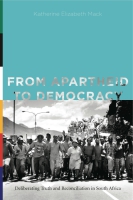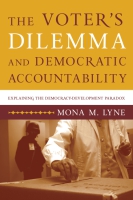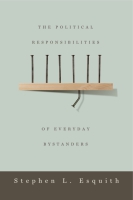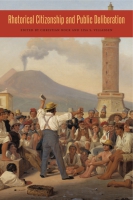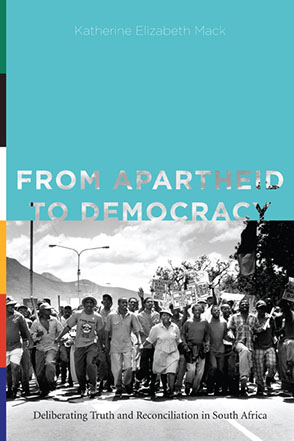
From Apartheid to Democracy
Deliberating Truth and Reconciliation in South Africa
Katherine Elizabeth Mack
From Apartheid to Democracy
Deliberating Truth and Reconciliation in South Africa
Katherine Elizabeth Mack
“Just as the [Truth and Reconciliation Commission]’s ambiguities and complexities opened opportunities for productive debate, so too does From Apartheid to Democracy create openings and invite rhetorical scholars to participate in an ongoing engagement with the TRC and other truth commissions. On the whole, the rhetorical nuance of Mack’s analysis adds much to existing scholarship on the TRC and transitional justice more generally, and her multigenre analysis deftly illustrates the utility of expanding the scope of rhetorical studies on civic deliberation.”
- Description
- Reviews
- Bio
- Table of Contents
- Sample Chapters
- Subjects
“Just as the [Truth and Reconciliation Commission]’s ambiguities and complexities opened opportunities for productive debate, so too does From Apartheid to Democracy create openings and invite rhetorical scholars to participate in an ongoing engagement with the TRC and other truth commissions. On the whole, the rhetorical nuance of Mack’s analysis adds much to existing scholarship on the TRC and transitional justice more generally, and her multigenre analysis deftly illustrates the utility of expanding the scope of rhetorical studies on civic deliberation.”
“From Apartheid to Democracy is, at its core, an insightful and occasionally moving study of rhetorical form. Katherine Mack’s reflective, accessible, and judicious analysis of the South African Truth and Reconciliation Commission demonstrates how the fundamentally multitextual character of the TRC produced commendable deliberative goods despite its documented shortcomings. Each chapter closely examines the generative interplay between a specific modality of public remembrance and its pragmatic function in the prolonged search for truth and reconciliation. Mack’s analysis thereby shows how multiple forms and forums of rhetorical deliberation may cumulatively assist in the difficult yet necessary work of reconciling long, painful, and often conflicting memories of violent injustice.”
“Issues of memory are perhaps never more contentious than during times of upheaval and transition. Katherine Mack’s careful exploration of the rhetorics surrounding South Africa’s Truth and Reconciliation Commission demonstrates the importance of these contests and draws our attention to the ways in which they take place not only in public hearings but also across a variety of texts, including the visual and the poetic. From Apartheid to Democracy offers an important reconceptualization of the work of truth commissions and broader efforts toward transitional justice.”
“Foregrounding the inherent rhetoricity of truth commissions, Katherine Mack's study chronicles the failure of South Africa's Truth and Reconciliation Commission to give voice to many whose humanity was brutally stolen from them. From Apartheid to Democracy not only opens space for understanding agonistic deliberation and artful dissent as reasonable responses to trauma but also expands the potential archive of public deliberation beyond the limits of phallogocentric ‘civilities.’”
“Katherine Mack’s innovative study of public memory in the wake of South Africa’s Truth and Reconciliation hearings will change the way we understand rhetorical analysis. Mack scrupulously charts the uneven trajectories of speech, print, testimony, performance, and image as they circulate in the new South Africa, producing spaces between formerly stable categories: history and fiction, speech and silence, victim and perpetrator. From Apartheid to Democracy is a courageous book, one that should be read by anyone interested in what humanities scholarship can contribute to contemporary struggles for justice.”
“In From Apartheid to Democracy, Katherine Mack takes a balanced, rhetorically nuanced approach to one of the most remarkable examples of transitional justice in the last century: the public memory activities of South Africa’s Truth and Reconciliation Commission. She skillfully examines both the TRC hearings’ rhetorical dynamics and their later representations in photography and literature. Her careful, well-written analysis persuasively demonstrates how the TRC’s goal of nation-building reconciliation enabled and constrained the kinds of rhetorical acts that could be performed during the hearings, while those same contextual forces became the target of criticism and thus of rhetorical agency on the part of participants and respondents. Not only will a wide range of rhetorical critics, political theorists, and cultural historians find this a thoughtfully suggestive book, but so too will anyone interested in what Mack describes as ‘the tight braid of cultural and political projects.’”
“An important and original contribution in the field of transitional justice. It is accessible to a broad range of readers but will be of particular interest to practitioners and scholars interested in understanding how truth and reconciliation processes impact democratic transitions.”
Katherine Elizabeth Mack is Assistant Professor of English at the University of Colorado, Colorado Springs.
Preface
Acknowledgements
Introduction: The Rhetoricity of Truth Commissions
Chapter 1: Localizing Transitional Justice in South Africa
Chapter 2: Ambivalent Speech, Resonant Silences
Chapter 3: Contesting Accountability
Chapter 4: Imagining Reconciliation
Conclusion
Bibliography
Chapter Overview
Chapter 1 sets the stage for this analysis. In it, I analyze the proceedings of two Justice in Transition conferences to reveal the interplay of national and international arguments about truth telling that led to the particular form and distinctive rhetorics of the South African TRC. While the Commission’s focus and goals evolved over the duration of its existence, certain of its key claims, what Paul Gready calls the TRC’s “meta-message” (71)—namely, those concerning the healing power of speaking one’s truth, the accountability of individual perpetrators, and the desirability of reconciliation—circulated with enough coherence and consistency to provoke the critical receptions that the subsequent chapters examine. From Apartheid to Democracy focuses on these highly publicized receptions of the Commission’s meta-messages by oft-cited victims and notorious perpetrators—so publicized, in fact, that their TRC hearings generated imaginative responses.
Chapters 2 through 4 exemplify the argument that the TRC’s public dimensions—in the dual sense of the hearings being open to the public and of their subsequent uptake and circulation—generated agonistic deliberation that began in the TRC hearings and continued in their imaginative receptions. Each of these chapters focuses on a particular topos (place of argument) that the TRC introduced into circulation: accountability, speech and silence, and reconciliation. I understand topoi to be “bioregions of discourse” that become recognizable as topoi when they function as inventional resources for rhetors (Eberly 6). My analysis travels across time, space, and genre, following various lines of reasoning. I first examine each topos as it was established by the TRC. I then note how it sprouted in its travels from the TRC mandate to the commissioners’ statements during the public hearings and finally to the Report. I examine varied receptions of the Commission’s process that stem from these topoi, including those of participants in the public hearings and select literary and photographic texts that represent or explicitly reference the TRC process. These receptions contribute to the “cultural conversation” about South Africa’s past that the TRC helped to instigate (Mailloux 54). My method is inspired by that of anthropologist Fiona Ross, who “trac[es] the shifts of interpretation, the processes of social reworking, [and] the grounds of acceptance on which narratives come to rest” (102). Unlike Ross, who studied the reception of women’s TRC testimonies in their hometowns and the effects of this reception on their everyday lives, I track the evolution of these topoi from the public hearings into a range of imaginative texts. These “imaginative combinations” provide insights and make arguments that were difficult, if not impossible, to express during the public hearings due to the rhetorical and ideological constraints of the TRC process (Ndebele, “Memory, Metaphor” 21).
Chapter 2, “Ambivalent Speech, Resonant Silences,” interrogates the assumptions about speech, dignity, and selfhood that informed the hearings of the TRC’s Human Rights Violations Committee, and, more specifically, the special women’s hearings that the TRC held to counter the silence of women victims of apartheid-era violence. How did women survivors of sexual violations challenge the TRC’s assumptions about their needs and healing process, best exemplified by the TRC’s maxim “revealing is healing”? After tracing the ideological origins of the Commission’s approach, I examine the experience of one woman deponent, Thandi Shezi, with the TRC. I then follow the arguments around the topos of speech and silence into Achmat Dangor’s novel, Bitter Fruit (2001), which shows how, contra the TRC’s logic, a woman’s decision to maintain a public silence can simultaneously facilitate and reflect her growing independence and sense of agency. This chapter challenges the logic of human rights discourse and the Western rhetorical tradition, both of which equate discourse and the speaking subject with power and presence.
Chapter 3, “Contesting Accountability,” examines the conflict between the Commission and anti-apartheid activists’ ways of framing the past and determining accountability. I outline the historical and ideological origins of the TRC’s unwillingness to address the effects of apartheid’s systemic racism and its concomitant focus on the individual perpetrator. I then ask how black perpetrators, in particular, responded to the constraints imposed by the Commission’s liberal, and thus race-blind, ideology. To answer this question, I analyze the testimonies of two well-known and controversial figures, former Umkhonto we Sizwe soldier Robert McBride and Winnie Madikizela-Mandela, Nelson Mandela’s former wife. I then follow arguments around the topos of accountability into Njabulo Ndebele’s novel The Cry of Winnie Mandela (2003). This chapter demonstrates how and why the TRC’s approach conflicted with anti-apartheid activists’ understanding of the collective struggle to end apartheid.
Chapter 4, “Imagining Reconciliation,” examines TRC participants’ visual and verbal arguments around the topos of reconciliation as those arguments appear in Jillian Edelstein’s photographic essay, Truth and Lies: Stories from the Truth and Reconciliation Commission in South Africa (2001). As in the previous chapters, I begin with an analysis of the Commission’s complex, and at times contradictory, arguments about reconciliation, focusing particularly on its linking of reconciliation to democratic praxis. I then show how the individuals whose portraits and testimonies appear in Edelstein’s Truth and Lies complicate the TRC’s vision by differently “imagining” both the process of reconciliation and the nature of democratic relations in the new South Africa that the TRC sought to create (Asen 351). Drawing on Robert Asen’s understanding of the “collective imaginary” as a source of “topics of discussion” (351), and Barbie Zelizer’s argument that images invite speculation by “activat[ing] impulses about how the ‘world might be’ rather than how ‘it is’” (164), I suggest that Edelstein’s photographs function rhetorically by inviting speculation about the emergence of democratic norms and the possibilities for coexistence in the new South Africa. Truth and Lies thus showcases rhetoric’s function as an art of invention “capable of creating new versions of the real and the valuable” (Atwill 206). Finally, the conclusion considers the methodological implications of my study by further elaborating on the importance of reading across genres in politically contentious situations.
Mailing List
Subscribe to our mailing list and be notified about new titles, journals and catalogs.
